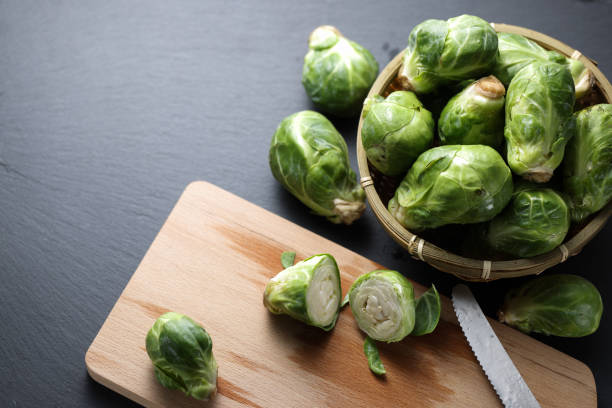Brussels sprouts, offal, coriander: Just thinking about these foods makes the hairs on the back of many people stand up. Many dishes polarize: either you love them or you hate them. We’ve compiled the top eight German “hate-love dishes” and explored what constitutes the disgust factor.
1. Unloved organs: innards
While in many other cultures offal is considered delicacies, most Germans disgust them. Only horsemeat is less popular. That wasn’t always the case: in the 1980s, kidneys, liver or almost forgotten dishes like tripe were still on many menus.
Where does the disgust with innards come from? In this context, some researchers speak of “invisibilization”: Although we want to eat meat, it should neither look nor taste like meat. And innards unmistakably reveal where they come from – from the animal.
Therefore, in Germany, almost only muscle meat, breast, and fillet are now for sale. Offal is quite healthy: The liver, for example, is a good supplier of potassium and iron.
2. Childhood Hate Food: Cabbage

“Chocolate is God’s excuse for Brussels sprouts,” a friend recently told me. Many people remember with horror the bitter little heads of cabbage that lay in front of them on the plate in their childhood and just didn’t get any less.
And even our parents and grandparents often wrinkle their noses at the thought of cabbage, as it was considered “poor man’s food” and its musty smell filled the hallways of apartment buildings. Disgust at cabbage is probably a mixture of both: the experience of our parents (who associate times of deprivation with cabbage dishes) and disgust at the typical smell of cabbage.
Incidentally, the particularly pronounced disgust with Brussels sprouts is often due to the fact that the small, tender bulbs become bitter if they are cooked for too long. If you want to give Brussels sprouts another chance, you should enjoy them roasted or baked: This way, the extremely healthy vegetable retains its bite but is milder in taste.
3. Innate loathing: cilantro
For some, coriander is the icing on the cake in soups and salads – for others, the herb just tastes like soap. Whether one hates or loves cilantro is said to be partly in the genes: a part of the genome that is responsible for the construction of human olfactory receptors seems to determine whether we find cilantro tasty or disgusting.
Around 17 percent of Europeans disapprove of the taste of coriander, and surprisingly the figure in Asia is even higher at 21 percent. Good news: you can get used to cilantro despite your genetic disgust. For many skeptics, a trip to Asia, for example, is the initial spark to give the healthy spice another chance.
4. Like chewing on bicycle inner tubes: Seafood
Clearly, the oyster tops the seafood hate-love scale. While it is considered chic among gourmets to slurp down the slimy mussel meat with a squeeze of lemon, many people feel horrified at the very thought of oysters.
With mussels, calamari, and scallops, as with oysters, the core of the disgust is the consistency rather than the taste. “I can chew on a bicycle inner tube right away,” is a common comment about calamari fritti – many people, on the other hand, love the special texture of grilled calamari.
Quite apart from the (possible) disgust factor, seafood can also cause severe allergic reactions – keyword histamine intolerance.
5. Ripened stench: cheese
Tilsiter, Limburger, Appenzeller: Many types of cheese have the potential to contaminate the entire fridge and bring tears to your eyes. The smellier the cheese, the better the taste – at least that’s what cheese lovers swear. For many people, just the thought of eating stinky or moldy cheese makes them want to vomit.
Microorganisms such as mold or bacteria are responsible for the cheese aroma. They break down fat and protein into smaller compounds; this produces some unpleasant-smelling substances such as sulfur.
By the way, the worst stinkers are the cheeses matured with red culture. This bacterium feeds on the proteins in the milk, producing ammonia, amines, and sulfur derivatives. Even a tiny amount is enough to give the cheese its distinctive character. The Vieux-Boulogne, also matured with Rokulturen, holds the world record as the smelliest cheese.
6. Flavor Killer: Dill
The essential oils, which provide the characteristic aniseed taste of fennel or dill, are perceived by many people as having an unpleasant taste.
The disgust with fennel may also stem from the fact that children with almost all illnesses are generally treated with fennel tea. Some of these traumatic experience continues into adulthood.
7. Not for phobics: bananas

A horror film, a nightly walk through the cemetery – there are many things a banana phobic would put up with just to avoid having to be in a room with a banana. Bananophobia, the fear of bananas, does exist and is anything but funny for sufferers.
The good news for all bananaphobes: hypnotherapy can help to overcome the deep-rooted fear – after all, bananas are one of the healthiest types of fruit.
8. Healthy taste buds: cumin
Cumin in the bread, cumin in the sauerkraut, cumin on the onion tart – does that have to be? For many people, when they bite into a caraway fruit, the enjoyment is suddenly over. The essential oils contained are undoubtedly healthy and stimulate digestion, but divide the community in terms of taste.
Fortunately, there are alternatives for caraway haters who want to “defuse” flatulent dishes: cumin, the oriental sister of caraway, makes food just as easily digestible but has a milder taste.


